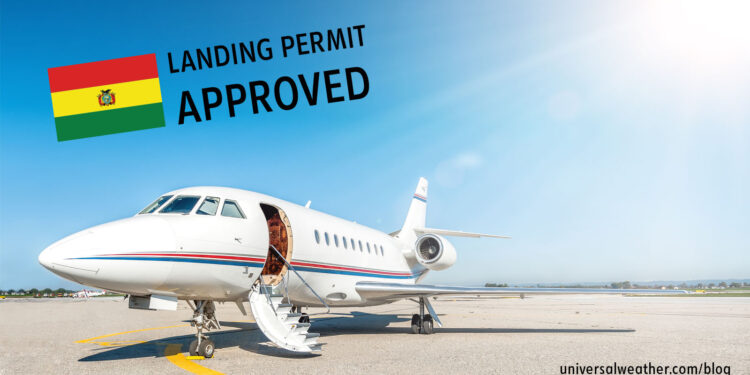Bolivia Landing and Overflight Permit Process Becoming Stricter

Bolivia has become stricter on landing and overflight permit requirements and lead times over recent months. If you are a business aircraft operator who travels in this region, it’s recommended that you work with your 3rd-party provider to confirm permit lead times, as well as specific documentation and procedural requirements. Below is an overview of what you need to know:
1. Know landing and overflight permit requirements for Bolivia
Both landing and overflight permits are required for operations to or overflying Bolivia for private non-revenue and charter (non-scheduled commercial) operations. Permits are processed by Bolivia’s Direccion General de Aeronautica Civil (DGAC) during normal operating hours: Monday-Friday, 0830-1630 local. Documentation requirements are the same for private non-revenue and charter flights.
2. Know documentation requirements for Bolivian landing permits
For a landing permit request, you’ll need to provide:
- Aircraft airworthiness certificate
- Aircraft registration certificate
- Pilot licenses and medical certificates – These documents must be issued by the same country as the registry of the aircraft
- Worldwide insurance (original of entire policy), which must state the following:
- Name and address of insured
- Full address of owner or name of insured if more than one company is insured (and list of companies, if applicable)
- Validity dates
- Indication if private non-revenue or charter
- Limits of company’s liability
- Description of the insured aircraft
- Aircraft use (this item is important)
- Medical expenses coverage to include the crew
- Geographical areas where insurance policy is valid
- Liability coverage
- Physical damage coverage
- Exclusions
- Liability and medical expenses coverage applicable to war, hijacking, and other perils exclusions
- Number of seats on the aircraft
- Copy of high-altitude performance chart from aircraft manual (only required for travel to La Paz [SLLP])
- Copy of aircraft operating manual, indicating the aircraft Maximum Takeoff Weight (MTOW)
In addition to the above, Bolivia wants to know the purpose of your flight. A generic business purpose can be provided for most operations; however, additional details should be given in cases of short-notice or VVIP operations. Be sure to provide all passenger details – including full name, date of birth, nationality, gender, and passport number and expiry date.
3. Know documentation requirements for Bolivian overflight permits
A copy of the aircraft flight manual, indicating MTOW, should be included with all overflight permit requests. Bolivia requires that permit requests be provided on company letterhead.
4. Know permit lead times
Four business days, in most cases, is required to process a private non-revenue or charter landing or overflight permit. In order to avoid permit processing delays, it’s best to provide as much information as possible regarding the purpose of flight and passenger details. In cases of diplomatic or air ambulance flights – or business flights with special circumstances – short-notice permits may be possible to obtain, so long as full details are provided to DGAC.
5. Permit lead times are taken seriously
Over recent months, DGAC has been much stricter in terms of permit processing lead times. In fact, they’ve denied more permit requests over the past six months than at any time in recent history. When requesting Bolivian landing or overflight permits, it’s important to provide the full four business days’ notice, as well as complete flight, aircraft, and passenger details.
6. Be aware of the reasons for permit rejection
Missing the fine details of Bolivian permit requests can get business aircraft operators into trouble, or delay permit applications, from time to time. For instance, not providing MTOW in your initial request or not providing a client fax number on the cover letter may delay a permit request.
7. Understand permit validity and revision particulars
Landing/overflight permits for Bolivia are valid +/- 72 hours. All revisions to schedule, aircraft, or crew must be provided to DGAC.
Conclusion
When applying for Bolivian landing or overflight permits, take the time to review all the minor details and requirements involved in the application process. Ensure that all crew and aircraft documentation is up to date. Be aware that your insurance policy may need to be revised to meet Bolivian standards. It’s important to be patient with DGAC. While their procedures and requirements are strict, few problems are encountered if the permit process is followed carefully.
Questions?
If you have any questions about this article or would like assistance planning your next trip to Israel, contact Christine Vamvakas at christinevamvakas@univ-wea.com.




